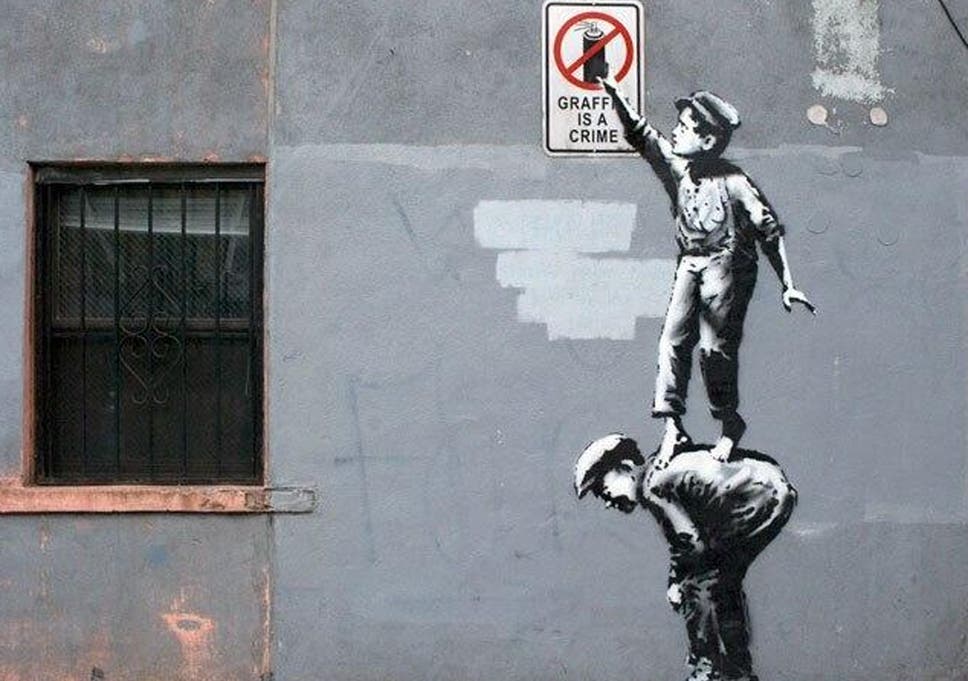In early October, the street artist Banksy destroyed one of his own artworks seconds after it had been sold at Sotheby’s Contemporary Art auction, an audacious prank that sent shockwaves through the art world and made national headlines globally. His disregard for the rules, on which as a graffiti artist his whole career has been based, was this time channelled against the system of the art market, a system in which Banksy’s influence has been growing for some time as the value of his work has increased in kind.
Banksy’s fame as the elusive Bristolian graffiti artist has been cemented worldwide, but how much does he owe his success to lesser known forerunners of the urban / street art movement, and just how original is his blend of humour, social commentary and stencilled designs? To read more about the relationship between Urban and Street Art, take a look!
Many commentators have drawn similarities between his work, and that of Blek le Rat, a French artist born in 1952 and who started politicising street walls with his images in the 1980s. Banksy stands out from the crowd for his use of stencils, the heightened definition of his figurative characters helping to increase their impact, but Blek le Rat was doing this well before him, more for practical than artistic reasons. He was arrested in Paris in 1991, and ever since used pre-prepared stencils as a time saving method, minimising his chances of being caught again. Banksy too has cited stencils saving time as being crucial to his work, as he found in his youth he would never have time to finish a whole piece in one go, as he was often interrupted by the police.
This shared technique does, however, lend a lot of visual similarity to their works, which many people fail to look beyond. Can you tell which of the three images below is a Banksy?

It's the one in the middle!
Their art aside, Blek le Rat is in many ways the antithesis of Banksy. Raised in a wealthy family with a private education, it wasn’t until his time at art school he came into contact with a world other than that of his own privilege. Banksy meanwhile, said to have grown up in the Bristol area of western England and later moved to London, has always had his roots in the underground scene. Maybe due to this difference, or because graffiti is in many ways more illegal in the UK than it is in France, that Blek le Rat actually felt comfortable revealing his true identity after a while. Xavier Prou, therefore, is the real man behind the mask, and his unassuming looks and middle class, ageing charm distance him from the stereotypical image of a youth with a spray can and paint splattered trainers.
His candour has led him to talk about his work much more openly than many of his peers ever could, and his message is simple. When people cannot come to galleries or museums for a whole host of reasons, he will take his art onto the streets. The rat is his symbol of this, long before it was appropriated by Banksy, an animal that can be found on streets globally. Even his moniker, Blek le Rat, was chosen specifically as it is an anagram of Art, the rodent’s omnipresence helping him spread the revolutionary message of the power of political statements through art.
Le Rat’s opinion of Banksy has been fairly mixed over the years, with him being overall pleased with what Banksy has done for the genre, and how Banksy’ presence in top auction sales globally has cemented their practice as high-class art.
“People say he copies me, but I don’t think so. I’m the old man, he’s the new kid, and if I’m an inspiration to an artist that good, I love it. I feel what he is doing in London is similar to the rock movement in the Sixties.”
As is often the case, imitation is the highest form of flattery, so le Rat can take comfort that his pioneering work has paved the way for not just Banksy, but a whole new generation of stencillers and street artists to copy and feed off his signature style. Even street artists like Frank Shepard Fairey, who has combined elements of Pop art into his street practice, whilst visually distint from le Rat, has been influenced by the political slant in le Rat's artwork. Read more about Frank Shepard Fairey here! However, the distinct similarities between himself and Banksy must often play on his mind, as le Rat admitted in the documentary Graffiti Wars,
“When I see Banksy making a man with a child or Banksy making rats, of course I see immediately where he takes the idea. I do feel angry. When you’re an artist you use your own techniques. It’s difficult to find a technique and style in art so when you have a style and you see someone else is taking it and reproducing it, you don’t like that. I’m not sure about his integrity. Maybe he has to show his face now and show what kind of guy he is”
Whatever Banksy's true feelings are towards this pioneer of the street art genre, one thing is for sure and that is that the student has become the master. Banksy is now one of the most famous artists worldwide, almost reaching a level of iconography, where as Blek le Rat has never achieved such renown and global recognition. However, it can be assumed that Banksy will not be lured by the luxuries and extravagences of the highest levels of the art world and will remember his humble beginnings. If his antics at Sotheby's in October are anything to go by, he is only just getting started!


